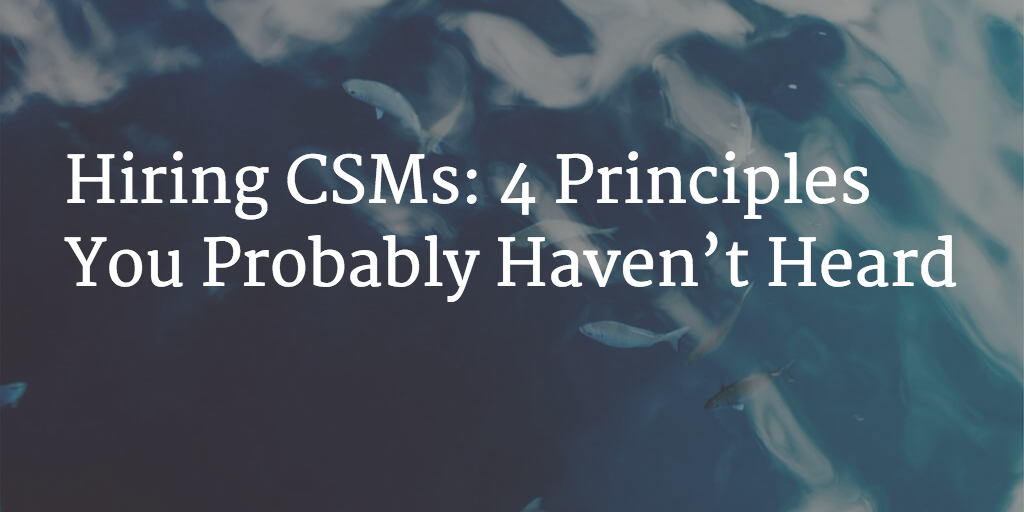A great deal has been written about how to hire CSMs, but CSM leaders continue to raise and debate the question. Here’s how we approach hiring at Gainsight. There are 4 principles that distinguish our approach:
- Hire process-oriented people
- Hire them, regardless of where they came from
- Test, don’t guess
- Hire ahead of schedule
1. Hire process-oriented people
Customer Success is the most operationally complex department in a SaaS company.
Why is that? Here are some reasons, among others:
- Making a customer successful requires many different elements.
- Our success as a CSM team depends on our ability to work cross-functionally with several other departments.
- We have more data to work with than other departments. With data, comes responsibility.
- We need to adjust our approach to making customers successful with every major new product release.
To handle this complexity, we need to create structure out of ambiguity. That is, we need to create processes. I previously wrote about only some of the more basic, required processes here; there’s a long list!
To create thoughtful processes, you need a CS Ops lead, but you also need CSMs who proactively identify patterns in the challenges that they’re helping their customers overcome. I want to hire CSMs who don’t treat every problem as a one-off issue, but who dive into the root causes. That way, we can address those problems in the most effective, efficient way across the customer base.
In other words, I want to hire CSMs who are process-oriented.
Process-oriented CSMs also don’t treat an individual customer’s issue as a one-off problem for that account. They view that issue in the context of the broader situation, and design a process – a Success Plan – to get that customer back on track.
Of course, process-orientation isn’t the only attribute that matters. We also evaluate candidates based on:
- Communication skills:
- Able to run a meeting with multiple stakeholders
- Clear, articulate speaker
- Poised, confident presence
- Courageous, assertive
- Problem-solving ability:
- Curious about client’s business needs
- Able to dissect those needs
- Able to identify a product-based solution to those needs
- Resourceful
- Attitude:
- Shows persistently positive attitude in the face of challenge
- Passionate about tech, Gainsight, and making the customer successful
- Has an empathetic, consultative approach
That said, given that much of the history of customer success lies in “relationship management,” process-orientation is one of the most overlooked characteristics in the recruiting process, even though it is one of the most critical ones.
2. Hire them, regardless of where they came from
We will hire anyone who exhibits our 3 basic company values and can pass our rigorous screening and testing process. I don’t care if you worked at a hot tech company or if you come from a company I haven’t heard of. I don’t care if you have a Customer Success background. I don’t care if you are 25 years old or 55 years old. If you pass our test, you’re in.
That’s a radical concept. We will hire the most talented people, regardless of where they come from.
Of course, if your recruiter is doing outbound cold calls for you, s/he will have to screen for something. Otherwise, they’ll quickly exhaust their allotment of LinkedIn InMails.
Still, let me challenge you: don’t just search for people with “Customer Success” in their title. Our industry is new enough that the talent pool in CSM is still relatively small. Here are some backgrounds that you might not have thought about investigating:
- Operations managers. Look for people who have run internal cross-functional initiatives or PMOs.
- Project managers in Services departments or at Services companies. They know how to design and run a smart process.
- Management consultants. Look for people with experience at either implementation-focused firms, such as PwC, or strategy-focused firms, such as BCG.
- MBAs. They’re dying to join tech companies and have the multi-disciplinary background that will help them think creatively about CS strategies.
- Teachers. They have experience in training (teaching!) and know how to operate under stress.
- Recent college grads (including those right out of college). They love to join rotational programs where they can get exposure to different departments – including CS, Services, Support, and others – to help inform their choice of a permanent home.
What are the benefits of diversity? I see at least 3:
- Because we look for talent anywhere we can find it, we’ve got a top-notch team.
- Because team members have different opinions, we can cultivate the creative tension that allows our team to improve rapidly and continuously.
- Because we’ve got a motley crew, we’ve had to get in the habit of demonstrating tolerance for and – even better! – admiration of our differences, which creates a better environment for everyone.
3. Test, don’t guess
Here’s another challenge: skim the candidate’s resume, then throw it out.
If you’re going to hire talented people regardless of where they came from, you need an objective way to assess whether they’re truly talented. The resume typically doesn’t help much.
One critical step in our recruiting process is a hypothetical client meeting. Here’s how it works:
- We provide the candidate with the name of a real company that they should pretend is a Gainsight client.
- We provide an old copy of an “introduction to Gainsight” deck, as well as screenshots from an old demo org.
- The candidate prepares to hold a 45-minute, in-person, hypothetical client meeting. They assign roles to those of us who are on the interview panel (typically 3 people).
- They walk us through the deck, hold a consultative, discovery conversation about how Gainsight would address the client’s business challenges, and conduct a demo to illustrate the solution.
The candidate’s performance in this meeting tells us more than we could ever discover from a typical interview. Specifically:
- Process orientation: Did s/he provide structure to the conversation, walking the client through a thoughtful process of discovery and solution identification?
- Communication: Did the candidate show confidence and poise when presenting to a group that includes executives?
- Problem-solving: Did s/he demonstrate curiosity by asking questions about the client’s business? Was s/he able to problem-solve on the fly, by matching Gainsight’s capabilities with the client’s challenges?
- Attitude: Did the candidate do enough research about our value proposition and our solution to signal his/her passion for the role?
Simulating an activity that the candidate would actually have to do on the job is the best way to assess whether they would be good at it.
4. Hire ahead of schedule
Look at your account loads right now. Do any of your CSMs have spare capacity?
If not, then what will happen if one of your CSMs quits or is let go? What will happen if your Sales team beats their target in Q3? Not having a CSM to assign new accounts can make for a bad customer experience. On the other hand, if you assign additional accounts to a CSM who’s already at capacity, you can create a morale problem.
In Customer Success, more than in other departments, it’s important to have spare bandwidth. Tell your boss that it’s important for you to hire ahead of schedule.
Hold your team managers accountable for hiring ahead. We automatically assign accounts to our 3 teams based on the segmentation model that I described in an earlier blog post. Automatic assignment, along with a publicly viewable sales pipeline report in Salesforce, empowers each team manager to anticipate their hiring needs a couple of months in advance.
I consider hiring an A+ team one of my most important responsibilities. The principles above have made it possible.
If you have comments or questions about best practices for hiring, feel free to email Allison at apickens@gainsight.com. You can follow Allison’s blog posts on Twitter at @PickensAllison.

